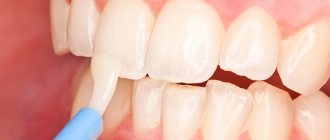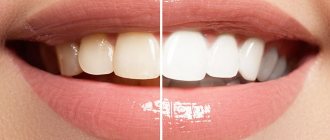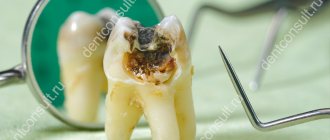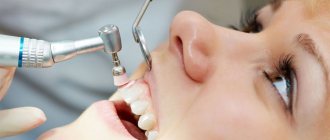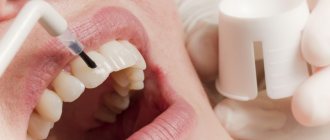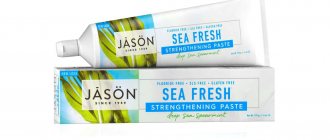To remain healthy, teeth must receive a sufficient amount of “building material” - a certain set of minerals necessary for their nutrition. Otherwise, they are affected by caries and begin to suffer from other diseases. Special dental procedures - fluoridation and saturation of teeth with calcium - help to replenish the reserves of useful minerals in case of their chronic deficiency in the enamel. It allows you to improve the appearance of your teeth, protect them from bacterial damage and premature destruction.
Fluoridation is the saturation of tooth enamel with fluoride, as well as the main minerals that form bone tissue: calcium, magnesium and others.
During the procedure, harmful bacterial flora is destroyed, fluoride ions penetrate the enamel structure. They restore and strengthen it from the inside. This provides effective prevention and treatment of caries at the stain stage, and also helps reduce tooth sensitivity.
What is dental fluoridation?
Fluoridation of teeth is an effective method of strengthening tooth enamel and protecting teeth from caries.
A deficiency of fluoride and calcium in the human body inevitably leads to the destruction of dentin (the main part of the tooth) and the enamel covering it. The result is increased tooth sensitivity, a tendency to develop caries, and periodontal disease.
Fluoridation is a painless and absolutely safe procedure, the essence of which is to apply a thin layer of fluoride-containing compounds (fluorides) to the surface of the teeth.
After fluoridation, it is recommended not to eat for several hours (4-6 depending on the drugs used), and also not to drink too hot or, conversely, cold drinks. In addition, you should refrain from eating solid food for 24 hours. These recommendations are due to the possibility of damaging the protective layer of fluoride applied to the teeth. If deep fluoridation has been carried out, you can eat and drink immediately.
Deep fluoridation of the 1st tooth
The diet of modern children is far from perfect. High-carbohydrate soft foods not only do not provide the necessary load on the teeth, but also contribute to the development of microorganisms that destroy the enamel structure. Despite the fact that saliva contains the minerals necessary for its restoration, the composition of saliva changes due to unbalanced nutrition, stress, and decreased immunity. As a result, the protective functions of tooth enamel are reduced and exposed to the destructive effects of caries. One of the main ways to strengthen enamel is fluoridation of teeth.
Fluoridation of teeth in children is a procedure for saturating tooth enamel with fluoride ions through the application of special fluoride-containing compounds that increase the strength of teeth and resistance to adverse influences. This is an effective alternative to extremely unaesthetic silvering, after which children’s teeth turn black. At pediatric dentistry, Dr. Dobryakov, we offer fluoridation of baby teeth as a preventative measure and, in certain cases, to stabilize the carious process. The preparations used contain fluorine compounds - fluorides, which reduce the harmful effects of acids and restore enamel.
What is fluoridation and why is it needed?
A procedure called fluoridation
- This is an extremely important preventive measure in pediatric dentistry, which should never be neglected. It is difficult to overestimate its importance, because it helps to effectively prevent the development of caries on children's teeth. Let's figure out what fluoridation is? Fluoride is a vital microelement for dental health, necessary for proper growth and development of teeth. If it is not enough, the tooth enamel becomes thinner, and the teeth begin to react to hot, cold and other irritants. Consequently, fluoridation can be called the process of remineralization (restoration) of tooth enamel, as a result of which the lack of fluoride is replenished and its destruction is prevented.
A timely fluoridation procedure is an excellent protection for your baby’s fragile teeth from any adverse effects, such as:
- mechanical damage to enamel,
- temperature changes,
- the effect of acidic environments on teeth, etc.,
which will not only make the teeth stronger, but can also stop the further development of caries in primary teeth if treatment occurs in the early stages of its development.
At the Doctor Dobryakov clinic, we offer our young patients several types of fluoridation.
Simple fluoridation
or the express method is carried out using two methods:
- This is the application of fluoride-containing gel to the teeth using special trays for 10 minutes. This is a very effective method, but requires regular repetition because it does not promote the penetration of calcium fluoride into the deep layers of enamel and can be removed a little each time your child brushes his teeth. To obtain maximum results, several procedures are necessary.
- Coating of tooth enamel with fluoride varnish. After removing plaque, fluoride varnish is applied to the surface of the teeth using a special brush and dried for 1-2 minutes. However, microcrystals of calcium fluoride do not penetrate into the micropores of the enamel and are gradually removed by mechanical action. Therefore, the preventive effect of using fluoride varnish is short-lived.
A truly effective method of remineralizing enamel, especially children’s primary teeth, is deep fluoridation with an enamel-sealing liquid.
.
The enamel-sealing liquid consists of a set of two liquid preparations produced by Humanchemie (Germany), which are sequentially applied to the surface of the teeth:
- enamel-sealing liquid (contains fluorides, magnesium and copper salts)
- and copper-calcium hydroxide (metastable colloidal system).
These components are applied to the tooth enamel sequentially. Thus, the active substances of fluorine and calcium penetrate into the deep layers of tooth enamel, nourishing the tooth and making its enamel much stronger, which significantly reduces the risk of developing caries.
Stages of deep fluoridation of baby teeth
The procedure for deep fluoridation of teeth at the Doctor Dobryakov clinic is absolutely painless and represents a sequential set of manipulations:
- At the first stage, the doctor cleans the surfaces of the teeth and interdental space from dental plaque and tartar, i.e. carries out professional cleaning
- At the second stage, the child’s teeth are thoroughly dried and coated with an enamel-sealing liquid using an applicator, then drying again
- And at the final stage, the little patient’s teeth are stained with a swab with copper and calcium hydroxide and also dried. Upon completion of the procedure, simply rinse your mouth thoroughly with water.
As a result of a molecular reaction, submicroscopic crystals of calcium fluoride, magnesium, and copper are formed, penetrating into the deepest layers of enamel and strengthening it from the inside throughout the year. Copper fluoride crystals also have an additional bactericidal effect. If we compare deep fluoridation with simple fluoridation, then the number of fluoride ions after deep fluoridation is 10 times higher than the concentration of ions after the shallow fluoridation procedure. Moreover, their effect is prolonged from six months to one and a half years.
Fluoride crystals remain in the micropores of the enamel for 0.5-2 years and gradually release fluoride ions, which ensure effective remineralization.
Indications for fluoridation in children
In what cases is it necessary to take a child for deep fluoridation? This procedure is especially indicated in primary dentition, from the appearance of the first teeth and during the period of change to permanent ones. The immature enamel of an erupting tooth is porous and easily susceptible to caries, so it requires effective protection.
There are additional indications for deep fluoridation:
- Microtraumas and thinning of tooth enamel (cracks, chips)
- Caries in the white spot stage (initial stage)
- Teeth react to temperature, as well as various taste stimuli
- Fluoridation after dental treatment is an additional protection and also extends the life of the filling.
Fluoride enters the body of both children and adults mainly through water. Many countries specifically fluoridate their water; unfortunately, in our country we are forced to take care of our dental health ourselves. Therefore, deep fluoridation is an ideal prevention of caries, especially in regions like ours, where the fluoride content in water is not high.
When should fluoridation not be done?
There are no special contraindications to the deep fluoridation procedure for children's teeth. You just have to remember that an excess of fluoride, like its deficiency, is also fraught with danger - this is fluorosis, when teeth crumble and enamel erosion can occur. Therefore, before doing deep fluoridation, be sure to consult your doctor. You should carefully choose a doctor, evaluate the recommendations of friends and avoid questionable clinics!
Fluoridation VS Silvering
Silvering is a budget alternative to the fluoridation procedure. It has a vaguely similar effect, but has one big aesthetic drawback - it turns children’s teeth black forever
(on the picture).
That is, until the baby teeth are replaced by permanent ones, your child will walk with dark, almost black teeth, which can cause him psychological trauma and wean him from the habit of smiling widely and openly. For this reason, in pediatric dentistry, Dr. Dobryakov, we have abandoned the silvering procedure and only carry out various types of fluoridation.
Why coat your teeth with fluoride?
So what does fluoridation do? This method can be used by both adults and children to strengthen enamel and improve its strength properties.
Fluoride is an important element that not only makes enamel stronger, but also prevents the rapid proliferation of bacteria. Among other things, the resistance of teeth to an acidic environment increases, which means their surface becomes less susceptible to various types of destructive substances.
The fluoridation procedure must be repeated annually - then the teeth will be reliably protected from caries and not subject to premature destruction; The gradual leaching of calcium will stop, making the enamel stronger.
Types of fluoridation
Currently, fluoridation of teeth is carried out using two methods - simple and deep:
- Simple fluoridation . To carry out the procedure, special “spoons” are used that look like mouth guards, which are filled with a fluoride-containing composition and placed on the jaw for 10-15 minutes. To complete the full course, you need to conduct at least 10 sessions. An alternative option is simple fluoridation using a fluoride-containing varnish. It is applied with a special brush to the surface of the teeth and allowed to dry. The full course consists of 3-4 procedures, depending on the individual characteristics of the body and the drug used.
- Deep fluoridation . The main difference between this method and the previous one is the use of special enamel-sealing preparations. In addition, deep fluoridation requires careful preparation of teeth, therefore it is carried out exclusively in professional clinics. After the stage of cleaning the teeth, a special composition is applied to their surface using a tampon for 1-2 minutes, after which it is dried under the pressure of warm air. Then the surface of the teeth is stained with a swab dipped in calcium copper hydroxide milk, and then rinsed with clean warm water. The advantage of deep fluoridation is that the solution penetrates into the deep layers of enamel, making teeth much stronger. According to dentists, the effectiveness of deep fluoridation is 5 times higher than that of simple fluoridation.
How to use
Instructions for applying teeth whitening varnish
- The varnish should not be applied to the damp surface of the teeth, as it will not adhere to the enamel. Before applying the varnish, you need to clean and dry the surface with a napkin or cotton pad.
- Some manufacturers add a retractor to their whitening kit. If available, place it in the mouth.
- Shake the bottle before use.
- The varnish is applied in a thin layer to the surface of the tooth in the direction from the gums to the cutting edge.
- Wait the recommended time for the polish to dry without covering your mouth. If necessary, apply a second coat of varnish until the enamel is completely covered.
Teeth whitening varnish can be treated at least every day.
Algorithm for applying fluoride varnish
- The working field is isolated from the adjacent surfaces of the lips.
- The surface of the teeth is dried with a cotton swab.
- The doctor coats the teeth front and back with fluoride varnish using a special brush or applicator. The number of applications is determined by the dentist.
- The patient needs to sit with his mouth open for 5 minutes to fix the composition.
It is recommended to carry out fluoridation in the dentist's office 2 times a year.
Benefit
As already mentioned, the main goal of fluoridation is to strengthen tooth enamel. In addition, there are other advantages of this procedure:
- The sensitivity of the teeth is reduced, so there is no discomfort when consuming cold and hot food or drinks.
- The risk of developing caries is reduced due to a reduction in the number of pathogenic bacteria and increased resistance of teeth to an acidic environment.
- Fluoridation prevents calcium from being washed out of tooth enamel, making teeth stronger and stronger.
Harm
As you know, you need to know moderation in everything. Those who like to experiment with various fluoride-containing drugs need to know the following:
- Fluorides are toxic substances that in large quantities can cause serious harm to the human body. Therefore, if you prefer to use toothpastes with fluoride, then it is better to refrain from the fluoridation procedure. And vice versa - if you have coated your tooth enamel with fluoride, then you should choose toothpastes that do not contain this chemical element.
- Fluorosis is an excessive accumulation of fluoride in the body. Fluorosis leads to brittle bones, anemia, and neuralgic abnormalities. As for teeth, when fluoride accumulates excessively in them, the enamel begins to rapidly deteriorate, which invariably affects their appearance.
Can the procedure be performed on pregnant women?
Fluoridation is not dangerous for pregnant women; moreover, it is recommended to many mothers. The reason is simple: during the period of bearing a baby, women often begin to lose teeth due to reduced immunity. To prevent the destruction of enamel from pathogenic microbes, and at the same time protect the unborn child from infections, the doctor can prescribe the procedure in the clinic or offer a choice of fluoride-containing elixirs and toothpastes for home fluoridation of teeth. The main thing to remember is that in some regions, drinking water may contain high levels of fluoride, and it is better if your doctor is aware of these local differences so as not to exceed the recommended amount of fluoride in your body.
pixabay.com/
Fluoridation of teeth during pregnancy
During the period of bearing a child, most of all nutrients and minerals from a woman’s body go to the formation of the skeleton and muscle tissue of the unborn baby. Due to calcium deficiency during pregnancy, tooth enamel is destroyed, so fluoridation during this period is very useful. However, before applying fluoride to your teeth, you should have your mouth examined and consult an experienced dentist.
It is important to remember that severe toxicosis is the main contraindication to the procedure, so it is best to plan a trip to the dentist for the 2-3 trimester, when the pregnant woman’s health improves. During breastfeeding, the fluoridation procedure will also not be superfluous.
Fluoridation of baby teeth
Failure to take your child to the dentist will lead to problems with permanent teeth. An important component of the prevention and treatment of caries in children is enamel fluoridation. The procedure can be performed for the first time at the age of 3 years. It does not cause a negative reaction in children and helps prevent the development of dental phobia in the future.
Important! The procedure is prescribed to children only after undergoing tests - excess fluoride can adversely affect the child’s health.
Contraindications and indications
To the question “When should you resort to dental fluoridation?” there is no clear answer. Dentists suggest performing it for children and adults as a preventive measure for caries, but there are other indications for coating teeth with fluoride-containing compounds:
- Increased sensitivity. As a rule, it manifests itself in the form of discomfort when eating cold foods or drinks, fresh fruits or vegetables. Fluoridation helps strengthen the enamel, thereby reducing dentin sensitivity.
- Tendency to develop caries. If you often visit dentists for dental treatment, then fluoridation is an excellent way to extend the life of your fillings and also prevent the formation of new enamel damage.
- Recent gum disease.
- Accumulation of a large amount of yellow plaque at the base of the tooth (above the gum).
- The fluoridation procedure is also carried out after removing braces.
- For children 6 years of age and older, fluoridation is recommended to prevent tooth decay and to maintain overall dental health.
Contraindications include only individual intolerance to certain elements of fluorine-containing formulations, as well as an excess of fluoride in the body. If the patient lives in an area where the fluoride content in the water is quite high, in this case the doctor will most likely offer you other preventative procedures to protect and strengthen the enamel.
Stages of the procedure
Regardless of the chosen fluoridation method, this procedure includes the following steps:
- Oral hygiene. This can be either a full professional cleaning (removal of plaque and tartar), or a simple treatment with antiseptic dental compounds. The tooth surface must be clean before applying fluoride-containing compounds so that the mineral substances can protect the enamel.
- Thorough drying with warm air.
- Depending on the chosen method of fluoridation, either fluoride-containing varnish is applied to the teeth, or a mouth guard with a special paste is put on for 10-15 minutes.
- During deep fluoridation, the surface of the teeth is covered with an enamel-sealing liquid, which is thoroughly dried and carefully shaded. After 1-2 minutes, rinse the oral cavity.
It is also important to understand that fluoridation is advisable only on healthy teeth, so before the procedure it is imperative to sanitize the oral cavity.
Prof. hygiene with 20% discount
Moscow
Fluoridation of teeth at home
Currently, preparations for fluoridation of teeth can be purchased in pharmacies or specialized clinics. Fluoride varnish is an effective remedy for strengthening teeth at home, but it should be used carefully and only after consultation with your dentist.
In order for fluoridation to bring visible results, it is necessary to take care of the cleanliness of your teeth. Next, you need to strictly follow the instructions included with the drug. Fluoride varnish should be used in courses - 3-4 procedures.
The most common way to strengthen tooth enamel is to use toothpastes containing fluoride. However, it is worth remembering that you cannot use these products for a long time - you need to alternate them from time to time with other drugs that do not contain fluoride.
How often should the fluoridation procedure be repeated?
The frequency of the procedure varies: if you have undergone deep fluoridation, then microscopic crystals have formed in your dental tissues, from which fluoride ions will “leak” over several years, so that the teeth will be maintained in good condition for a long time. For surface fluoridation, such as using a gel, the process must be repeated once a week. However, in order to avoid unpleasant consequences, all this, of course, must be monitored by a doctor.
One type of superficial fluoridation procedure is teeth cleaning. This type of fluoridation at home can be done using a simple fluoride-containing toothpaste, which is recommended to be used once every seven days. If it is prescribed to a child, be careful that he does not swallow it. Toothpastes and elixirs with fluoride can be easily purchased in pharmacies and even supermarkets.
pixabay.com/
Fluoridation and silvering: what is the difference?
The silvering method is the treatment of teeth with preparations containing silver nitrate. This method of combating caries is prescribed to the youngest children - up to 3 years old. The procedure is quick and painless: saliva is removed from baby teeth, then they are impregnated with a silver preparation. Silvering is used only at the initial stage of caries - “white spots”, and can stop the development of the disease, but does not cure it. In addition, a big disadvantage is the darkening of the teeth as a result of the procedure.
In dentistry, this method is now almost never used, giving way to a more effective fluoridation technique. The procedure is as simple as silvering, but it has advantages over the latter: fluoridation not only prevents the development of caries, but also strengthens tooth enamel.
Is there a noticeable difference in the external appearance of teeth before and after fluoridation?
It should be noted that the fluoridation procedure is by no means teeth whitening, but the process of saturating tooth enamel and hard dental tissues with fluoride compounds. Changing the shade of the enamel is possible, but not radically, so you are unlikely to achieve a snow-white smile with fluoridation. The shade of enamel during fluoridation can change by about one tone. At the same time, fluoridation can effectively precede whitening, acting as a basic step in preparing the tooth surface, “healing” and strengthening it. Fluoridation can also be the final stage of bleaching.


